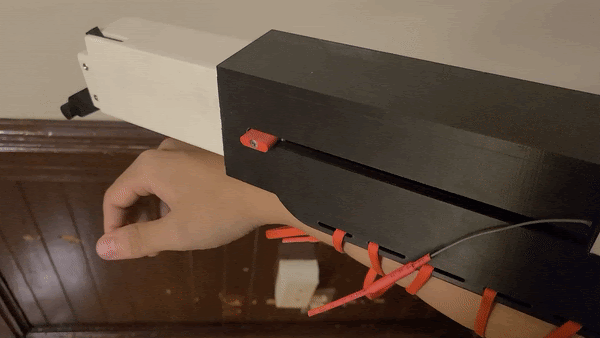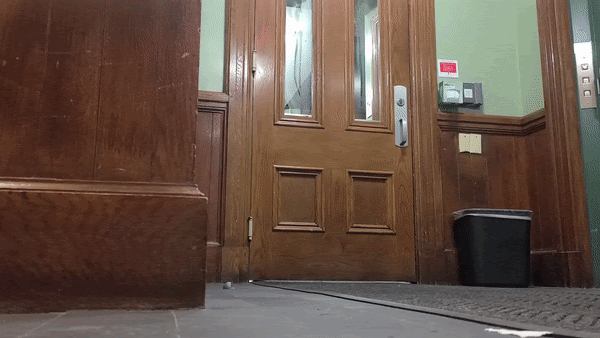Robotic Gauntlet
Wearable Modular Toolkit
Scroll down for videos.
This robot was envisioned by Si Chiang Wu as a helpful tool during the COVID-19 pandemic, and served as my team’s (Francisco Marquez, Si Chiang, and myself) final project for ENG-SCI 51: Computer-Aided Machine Design. The idea behind the robot is that it would extend a hook-like tool used to open and close doors so the user does not have to contact the door handle with their bare fingers. I came up with the idea that the end tool would utilize a mechanism that allows the wearer to use their fingers to pull a spring-loaded lever that simultaneously rotates the hook into position out of its protective shell and also directly transfers the user’s grip strength to the hook tool (so the user is pulling the door open, rather than the robot’s motor doing the pulling). Otherwise, the purpose of the robot would be silly; there already exist keychains that accomplish the same thing without a bulky robot strapped to your arm—my design gave the robot the newly-defined purpose of placing tools into the user’s hand on command.
Theoretically, one could switch out the spring-loaded hook with other end tools. We designed a few that could conceivably serve other purposes (such as a “button pusher”), though none of these proved to be particularly useful.
Videos by Francisco Marquez.
math23c_bot()
Statistics and Machine Learning in RStudio
This was my final project for MATH E-23C, a course at the Harvard Extension School. It was my attempt at "artificial intelligence” that could handle basic data science tasks, in the form of a compact R function that could take in a dataset as a parameter. The dataset I used for this project was the forestfires.csv file from the UCI Machine Learning Repository, which I gave to the math23c_bot() function in order to predict where forest fires are most likely to occur in a 9x9 grid of the Montesinho Natural Park in Portugal. You can read more here.
image from montesinho.com
Prismatic Mannequin
Chuck Hoberman-Style Humanoid Robot
Scroll down for video.
This cardboard-like robot was inspired by one of Chuck Hoberman’s origami-like humanoid puppets, and served as my final project for his Informal Robotics course, along with my partner Yanxi Lu.
Our humanoid is a culmination of several iterations experimenting with legged movement using prismatic structures. I wanted to explore the idea of adding powered actuation to Hoberman’s prismatic humanoid concept. Unfortunately, due to the class taking place during the COVID-19 pandemic, we were limited to only using geometric shapes given in the provided modular kit and had no means of laser-cutting our own shapes, and we were also limited to using a standard gearbox as opposed to a more precisely-controlled stepper motor. As a result, we had to get creative in order to precisely control what angles the gearboxes turned the two cranks that moved the robot’s arms and legs, by using a provided remote control kit to manually calibrate the positions of the crankshafts before each use.
Though the robot succeeded in standing upright and shuffling around, it still has a long way to go before I am satisfied in considering it a novel, walking, humanoid robot. For instance, as you can see in the video, the movement of the robot’s legs don’t really contribute that much to its “walking”—it’s really the swinging arms that provide most of the momentum leading to the net forward movement, while the legs just kind of awkwardly twitch as it slowly inches ahead.
Future iterations of the robot would utilize numerous improvements, including (but not limited to) custom laser-cut shapes, stepper motors, an onboard power supply and circuit board, and “roller skates” instead of cardboard skis for feet (with the wheels turning “one-way,” like many shuffling bipedal toys that exist out there). Some have also jokingly suggested that I scale up the robot to be the size of a real human.
Rob Hart's H-Bot
Digital Drawing Machine
This is a drawing robot originally created by Rob Hart, which I have adopted as my own pet project that I continue to improve and update. It was created as a demo for PHYSCI-70 (Intro to Digital Fabrication), a course at the Harvard College. You can read more here.
Pneumatic Robot Arm
With Soft-Robotic Gripper
This is a robotic arm I built for PHYS S-12 (Intro to Digital Fabrication) at the Harvard Summer School. You can read more here.
I am also continuing to update the robot. For example, I am designing a new circuit board for the robot’s controls as my final project for ENSC E-123 (Digital Circuit Design), which you can read about here.


